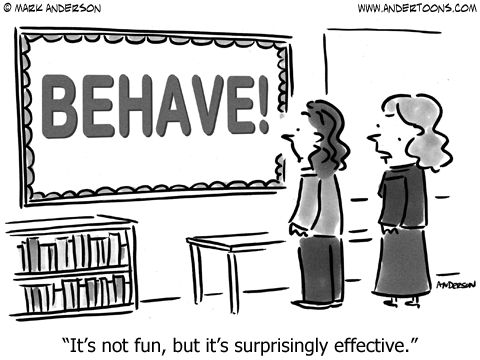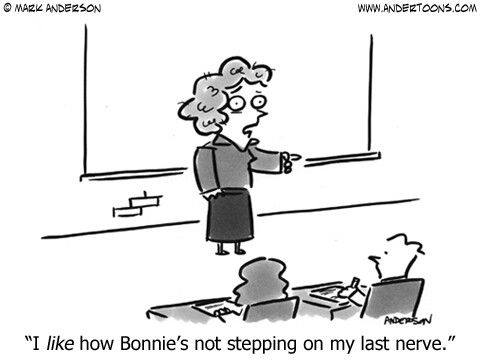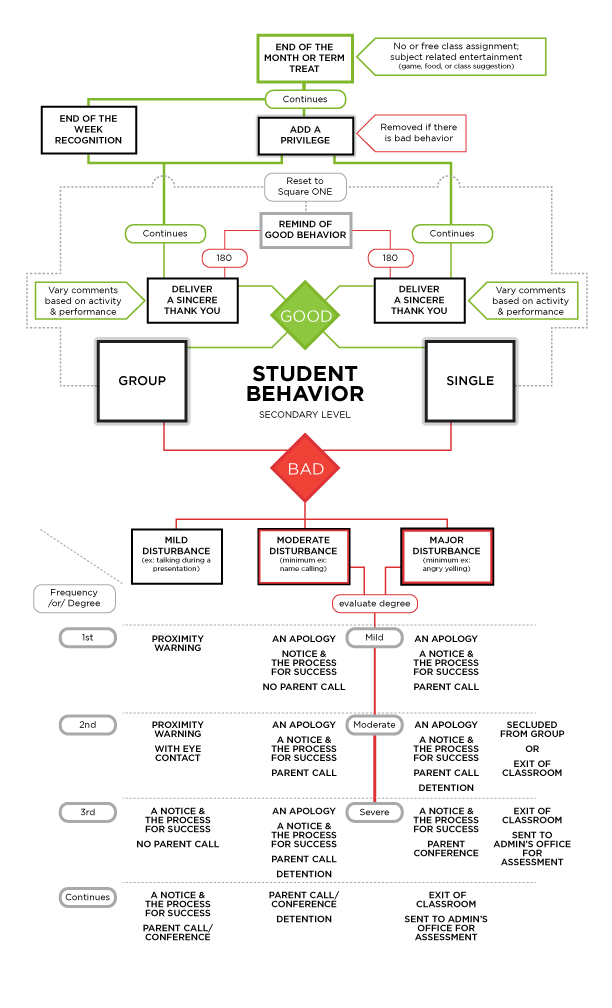This entry is an activity for Teach-Now while working towards a teaching certificate. Specific goals and requirements had to be met by this entry and is by no means designed to be an independent feature.
There will be basic rules and procedures assumed in the class based on overall school expectation: attend class; be on time; and proper conduct and respect. How the school enforces those rules should be discussed and agreed upon by the entire faculty and staff. However, there will be degrees of subjectivity and administration intrinsically based on our own translation and comprehension — that is going to happen. The classroom is a microcosm within the school to manage itself. Some of these rules will be based on school policy, some by default for the simple need and the remaining owned by the students to allow them the privilege of self-authority and responsibility.
In the classroom, behavior maintenance becomes my responsibility; I hope students will also be responsible for themselves and their peers’ behavior. Lets say that I am delivering the day’s content for an activity that requires their complete cooperative attention. A couple of students decide that their conversation has more importance and start their chatter. Certainly students have their own priority and feel that this sort of thing is more important; however, learning is in session and this activity implies cooperation. On the first incident of this disturbance, I would practice the commonly advised tactic of counter-distraction by my proximity to the original distraction. As responsible students, the more self-managed expectation would be a peer suggesting to the disturbing party to cease and pay attention; this I consider polite conduct in the class activity. I would not specifically recognize the student and their action. Why would I not specifically recognize the policing student? By doing so, I hope other students would be encouraged to do the same for their own progress. Directing attention to that one student points them out that student as a do-gooder and this tends to set them apart in the student society. I also do not want to encourage this student with self-empowerment to point out all behavior hoping to gain more pleasing remarks. If this action happened, the following discussion would require two tiers: one, calling out the bad activity allowing those student(s) to explore the reason; and two, calling out the tattle-teller that though it was productive to point out the bad behavior, the better action allows the students to discuss and problem and solve toward better behavior.
As a group, students work to solve their relationships by attending to the politics and status of their peers. Ultimately, it would be nice if all students were considered and treated equal, but in reality there will be a superficial hierarchy established and evolving. In any case if the student group cooperate beyond their differences to learn, their effort should be recognized either during the process to encourage more of the same behavior; or recognize the collaboration at the end to allow the productive practice to continue undisturbed without influence. Long-term good behavior could be rewarded more handsomely. The reward could come after a good week by giving a privilege or celebration. Again over time, I would continue with verbal appreciation and express how the good attitude works as a step toward progress in learning. If by some favored chance the class remains in an overall highly positive behavior for the whole semester, I could surprise them with a small token of appreciation by a small party or a class trip related to the subject. Another reward option could be giving the class the privilege to grant their own reward—that would be two rewards in one!
Good behavior does not ideally happen all the time — that would be too perfect and just not reality. The pragmatic approach needs a behavior plan to distract bad manners or a process to educate why that behavior should be avoided and how it can replaced.
Returning to the disruptive conversation during a presentation, again the first step would be attending the activity simply by placing my body in the vicinity. Students, or any troublemaker, want to avoid getting caught when they know their actions are mischievous; in the proximity of authority, the offender ends the bad act and pretends that no such action had happened. That response is fine as long as they return to classroom cooperation. What if the villains continue with the chatter after I leave their circle? A second warning comes, again, with the proximity technique but with the eye contact warning. This warning essential states: “I was aware of your first misdemeanor, and I am warning you of your defiance by this last warning.” Essentially that warning implies that I will enforce discipline by a notice and the “Process for Success.” Productive behavior management means bad behavior should not be punished; instead, bad behavior could be fashioned as an opportunity to learn the appropriate behavior in class. The student has a chance to redeem themselves and to productively change their behavior. Talking in class is not a severe violation; the offense can be identified as mild which will not necessarily need a home followup. However, if the minor disruption becomes a pattern I could enforce a stricter reaction by informing the parents engaging them to continue the behavior management. On the occasion that the second tier of productive discipline does not work, I rearrange the classroom notifying the entire student group why we had to. This embarrassing reveal may deter others from such behavior.
I am hoping that I do not experience much if not any moderate or major disruptions. Generally, a moderate disruption may involve an offense attitude from one student to another such as ridicule by name-calling. Offending someone because of what they wear or think is simply rude. Reacting with mild-disturbance methods does not provide the correction.
One situation
During a student group activity, one student demeans their peer by suggesting that they are too poor to own decent clothes or even a washing machine. Sure, this comment may not seem harsh, but to the receiver it is. That recipient can no longer feel comfortable to be involved nor respected. I approach the group requesting an apology, asking for an explanation for the offender’s act, pushing further why it is not appropriate, and how they can work beyond it.
Another example
Someone had expressed a legitimate opinion during a class discussion. An audience member remarks that this person is “stupid” — again, offensive. In this case, the student’s rudeness should be retracted by offering an apology for their demeaning comment, and their thoughtlessness that people have opinions. For disrupting the class learning process, they are required to fill out a notice and follow a “Process for Success” to correct their behavior. On the other hand if their name calling held a more political or harassing nature such as a demeaning sexual nature or foul language, the reactive degree would be an additional corrective action with a call home hoping the parents would inform the offender that such interjections should not be given.
The major violation
Any forcefully rude or harmful act will not be tolerated or taken lightly. In my student behavior flow, I suggested that a major disturbance could be angry yelling. Angry yelling may be acceptable if it relates to an expression as a response. Yet, this action should be immediately removed from the class and explored through questioning by what provoked it and how a person could more maturely manage their anger. Then again if the angry yelling was directed to simply provoke an argument or ridicule another individual, the actor should be excused from class to cool down. Additionally, that student will need to learn how to correct their behavior by successfully identifying why their behavior was inappropriate and what actions they could have employed to better respect others; AND of course a call home will be required so that the parents can enforce the correction and further the discussion providing another perspective. There may be a situation where the student continued provoking though they were requested to stop. The student crossed to the detention tier and possible parent/teacher/student conference to correct the behavior.
I hope that I would never have to follow through any major disruption deterrence. I would be greatly concerned of how well I manage my coolness if a student violates the peaceful class operation and does not want to follow a corrective course. In those times, I would have to throw out a lifeline to a fellow teacher for assistance. The main goal means controlling the situation to avoid any harm to any individual and to maintain a level-headed attitude that does not destroy the student confidence and respect of me. An environment for learning should be a place to explore ideas, test considerations, and grow from success and mistakes. A classroom should not be a war zone that only creates a sense of dread of fear before entering. If I cannot maintain a healthy environment then I have failed to be a teacher and what it means to be a productive partner in the education.
Rules and procedures are established to help set a system of operation for people and society as a whole to function with a goal for productivity and progress; rules are not established to restrict. The Sleepy Hollow School of New York Student Handbook (SHHS, 2015) start off with basic rules: “Treat all staff members and fellow students with courtesy” is a basic rule of respect. The administration then expanded the rule of courtesy by other rules to refrain from assault and bullying and to refrain from verbal harassment. Essentially, courtesy implies that you should not bully or hit, but further definition by additional rules sets specific and clear objectives for a student to follow with clear knowledge. In all, the school system has 14 specific rules regarding student behavior while attending school; the rules are even encouraged as a guideline for societal behavior. In addition to the rules, there is an honor code regarding plagiarism, cheating, lying and conspiracy (SHHS, pg 4) making for a total of 18 rules for students and teachers to remember and track. On top of that, teachers will maintain their own rules within the classroom. There will be honest slips and intended disregards. The degrees of enforcement will greatly depend on immediate evaluation of the misbehavior, applying the correct response to the behavior, and most importantly being consistent of both the expectation and the response. A smooth running classroom would be ideal only if all students were intrinsically motivated to respect the purpose of class and education. Granted society will not — in all hopes of decency — be ruled by a “1984” discipline; rules simply enforce the basis of respect, responsibility, and personal pride.
Resources:
SHHS, Sleepy Hollow High School. (2015). Student Handbook 14-15. http://www.edlinesites.net/pages/Sleepy_HollowHS/For_Students
Header Cartoon. https://chroniclesofasingaporeanindiangirl.wordpress.com/2015/02/10/a-survival-guide-for-beginning-teachers/
Content Cartoon. Pinterest Board: Teacher Humor, Time to Laugh. https://www.pinterest.com/pin/237635317814487851/



